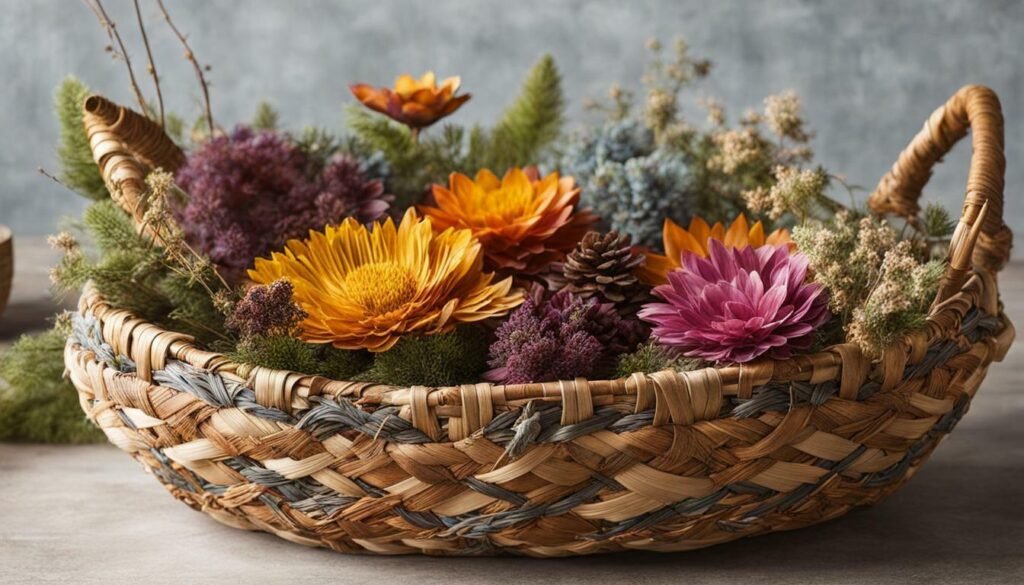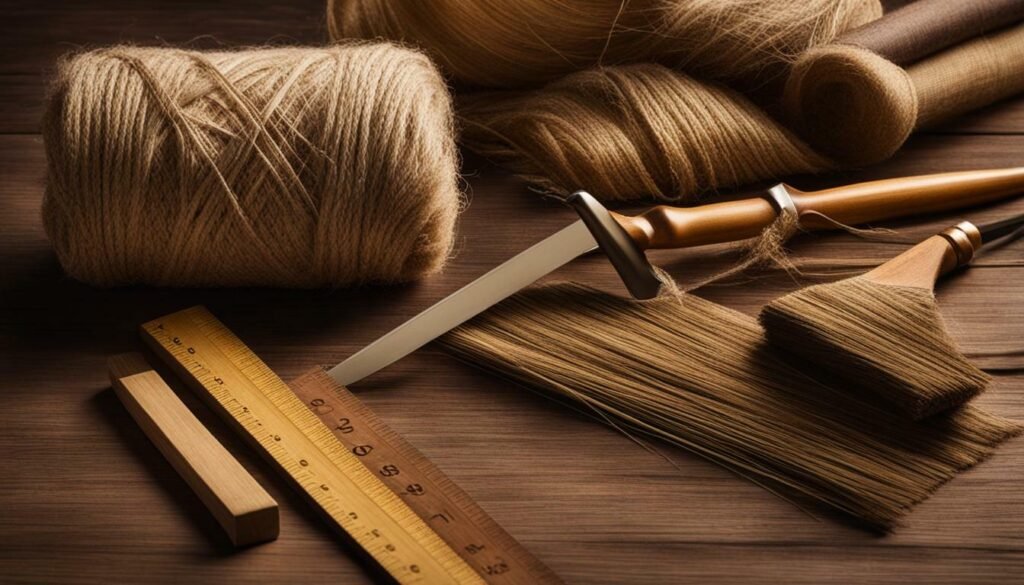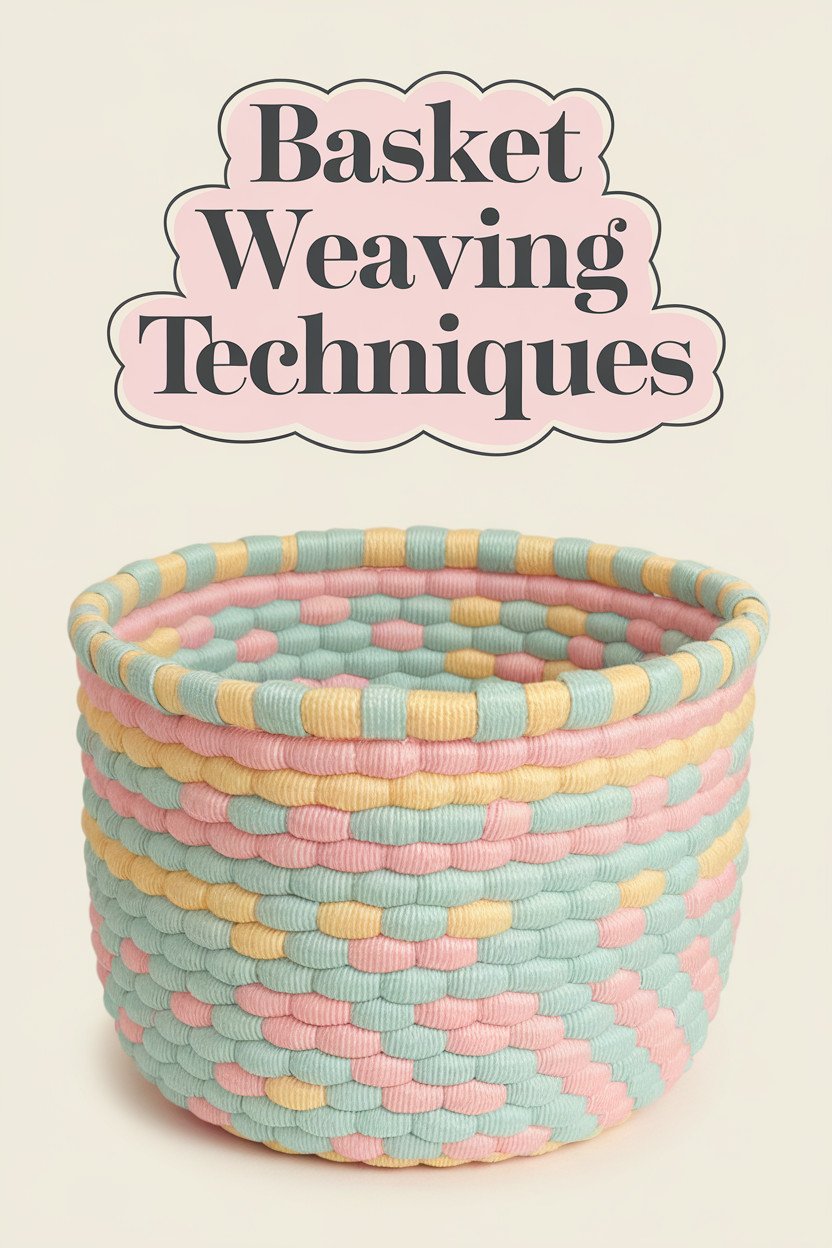The art of basketry has been around for centuries and is still cherished today for its beauty and practicality. Whether you’re a beginner or an advanced weaver, there’s always something new to learn and explore.
We’ll guide you through the basics of basket weaving, including techniques, patterns, and supplies. You’ll discover ways to challenge yourself with advanced techniques and explore the therapeutic benefits of basket weaving.
Key Takeaways:
- Mastering basket weaving requires patience, practice, and a willingness to learn and experiment.
- Beginners should start with basic techniques and supplies, such as a simple basket weaving kit and natural materials like reed or willow.
- Advanced weavers can challenge themselves with intricate patterns and unconventional materials like wire or recycled plastic.
- Basket weaving can promote relaxation, mindfulness, and mental well-being.
- Joining a basket weaving workshop or community can provide support, inspiration, and opportunities for growth and learning.

The Beauty and History of Basket Weaving
There is something truly mesmerizing about the art of basket weaving. As you learn basket weaving skills, you are not only creating beautiful objects, but you are also connecting with a craft that has a rich cultural history.
Basket weaving techniques have been passed down through generations, with each culture and region adding its own unique spin on the craft.
From the ancient Egyptians to the Native American tribes, baskets have been woven and used for practical purposes such as for storing food, carrying water, and transporting goods.
But over time, basket weaving patterns evolved into a form of artistic expression, with weavers incorporating intricate designs and patterns that rival any other art form.
Today, basket weaving continues to thrive as both a practical and artistic craft. As you learn basket weaving, you are not only developing a new skill, but also becoming part of a community that values tradition, creativity, and self-expression.
Getting Started: Beginner Basket Weaving
Welcome to the wonderful world of basket weaving! Starting out can seem daunting, but don’t worry – with a few supplies and some basic techniques, you’ll be on your way to creating beautiful baskets in no time. Here’s how to get started:
- Choose your supplies: You’ll need a weaving material (such as reed or cane), a pair of sharp scissors, a tape measure, a weaving needle, and a shallow dish of water. You can find beginner basket weaving kits online or at your local craft store.
- Prepare your materials: If your weaving material is in a coil, soak it in water for about 30 minutes before starting to soften it. Cut off the amount you need with scissors and keep the rest in the water to stay pliable.
- Start your base: To start your basket, create the base by weaving two or three pieces of your material together in a circular shape. Use your needle to keep the weaving tight and adjust the shape as needed.
- Add your sides: As you work your way up, continue to weave in a circular shape, gradually adding height to the sides of your basket. Keep the weaving tight and the rows close together.
- Finish your basket: Once you’ve reached your desired height, trim off any excess material and tuck the end under a few rows of weaving. Use your needle to secure the end in place.
- Experiment with patterns: Now that you’ve mastered the basics, try branching out with different patterns and designs. There are countless resources online for basket weaving tutorials and patterns.
If you’re ready to challenge yourself and take your basket weaving skills to the next level, it’s time to explore advanced techniques and patterns. Here are some tips to get started:
- Experiment with different weaving materials, such as wire, leather, or fabric strips.
- Incorporate complex weaving patterns, such as twill or triaxial weaves, to add texture and depth to your baskets.
- Explore the world of sculptural basketry by creating baskets with unique shapes and forms.
- Try your hand at creating baskets with multiple techniques, such as combining coiling and twining.
Exploring Basket Weaving Techniques
There are various basket weaving techniques that have been used throughout history. Each method has its unique style and beauty that can be applied to your own creations. Here are some techniques to explore:
- Coiling: This technique involves wrapping and stitching coils of material to create a spiral shape. Coiling can be used to create round and oval baskets.
- Twining: Twining involves weaving two or more strands of material, creating a strong, flexible structure that can be used for larger baskets.
- Plaiting: Plaiting involves weaving flat strips of material over and under each other to create a flat surface. This technique can be used to create intricate designs and patterns.
- Wicker Weaving: Wicker weaving involves weaving thin, flexible branches or stems together to create a sturdy basket. This technique has been used for centuries and is still prevalent today in traditional basketry.

Here are some tips to keep in mind as you experiment with patterns:
- Start simple: If you’re new to basket weaving, begin with basic patterns such as checkerboard or stripes. As you gain confidence, you can move onto more complex designs.
- Play with color: Adding color to your pattern can make your basket pop. Experiment with different hues and shades to create a truly unique piece.
- Mix and match: Don’t be afraid to combine different basket weaving techniques and patterns to create your own masterpiece. Let your imagination run wild!
- Think outside the box: Basket weaving patterns don’t have to be limited to traditional designs. Add your own twist by incorporating shapes or incorporating unconventional materials.

Before you start your basket weaving journey, make sure you have the essential supplies on hand. Here are the must-haves:
- Basket weaving materials such as reeds, cane, or willow
- A weaving basket or mold to shape your basket
- Weaving tools such as a pair of pliers, scissors, and awl
- A measuring tape or ruler to ensure accuracy
- A water container and spray bottle for wetting the materials
- A comfortable seat and good lighting for prolonged weaving sessions

The type of material you choose will affect your basket’s durability, flexibility, and aesthetics. Here are some popular basket weaving materials:
| Material | Pros | Cons |
|---|---|---|
| Reed | Flexible, easy to grip, and available in a variety of colors | May be prone to snapping or fading over time |
| Cane | Durable, lightweight, and ideal for intricate weaving patterns | May be more expensive than other materials |
| Willow | Natural, sturdy, and creates a rustic look | May require soaking or conditioning before use |
Essential Basket Weaving Supplies
Before diving into the art of basket weaving, it’s essential to have the right supplies on hand. Here are the must-haves:
- Basket weaving materials: Choose from a variety of materials, including reed, cane, bamboo, or willow. Select material based on the project you intend to create.
- Weaving tools: Essential tools include a weaving needle, scissors, a measuring tape, and a scribe tool.
- A work surface: Find a flat surface with ample space to work on. Many weavers create their own work surface with a piece of wood or cardboard.
- A water source: Keep a bowl of water nearby to soak weaving materials and keep them pliable.
- Basketry book: Keep a reference book or tutorial on hand to guide you through the weaving process.

Even the most experienced basket weavers encounter hurdles in their journey. When faced with challenges, don’t be discouraged – consider them opportunities to hone your skills.
Here are some common issues you may encounter and how to troubleshoot them:
- If your weave is too loose, tighten it by pulling each strand firmly.
- If your weave is too tight, loosen it by gently pushing each strand outward.
- If your tension is uneven, adjust it by pulling and pushing the appropriate strands until it becomes even throughout.
- If you make a mistake, carefully unwind the affected area and redo it.
- If a strand breaks, trim it and reweave it into your basket.
Incorporating Innovations in Basket Weaving
Take your basket weaving skills to the next level by exploring innovative techniques and patterns. Here are some ideas to help unleash your creativity:
- Experiment with unconventional materials, such as recycled plastic bags or wire mesh, to create unique textures and shapes in your baskets.
- Combine traditional weaving techniques with modern design concepts to create contemporary works of art that push the boundaries of the craft.
- Integrate technology into your weaving process, such as using digital design software or 3D printing, to create intricate patterns and shapes.
- Draw inspiration from different cultures and traditions to create fusion pieces that merge different styles and techniques.
By studying their masterpieces, you can gain a deeper appreciation for the techniques and patterns used in basket weaving, and find inspiration for your own creations.
- Observe the intricate details of each basket, noting the weaving techniques and materials used
- Pay attention to the overall form and shape of the basket, and how it complements the design
- Consider the color and texture choices made by the artist, and how they add dimension and visual interest to the piece
- Reflect on the historical and cultural significance of the basket design, and how it has been adapted over time.

Incorporating Basket Weaving into Your Daily Routine
Whether you’re looking for a new hobby or a way to destress after a long day, basket weaving can be a great addition to your daily routine. Here are some tips for incorporating basket weaving into your life:
- Set aside a specific time each day or week to weave.
- Create a dedicated workspace that is clean, organized, and free from distractions.
- Select materials and patterns that inspire you.
- Take breaks when needed to avoid straining your eyes, hands, and back.
- Connect with other weavers and share your progress and challenges.
Preserving and Passing On the Art of Basket Weaving
As you continue to hone your basket weaving skills, consider becoming part of the movement to preserve and pass on this timeless craft.
- Join a local basket weaving guild or organization, such as the National Basketry Organization or the Basketmakers Association, to connect with fellow weavers and participate in workshops and exhibitions.
- Volunteer at a museum or cultural center to learn about the history and cultural significance of basket weaving and share your skills with others through demonstrations and workshops.
- Consider teaching beginner basket weaving classes to pass on your knowledge and ignite a passion for this craft in others.
As a passionate basket weaver, you hold a responsibility to practice sustainable techniques for the longevity of this art form. By incorporating eco-friendly materials and minimizing waste, you can help preserve the environment and minimize your ecological footprint.
- Choose materials that are responsibly sourced, such as locally grown fibers or recycled materials
- Reduce waste by repurposing scraps and materials
- Use natural dyes or non-toxic alternatives for coloring
- Consider the lifespan and durability of your baskets when selecting materials
- Participate in initiatives and organizations dedicated to sustainable basket weaving practices

After all your hard work, it’s time to showcase your beautiful basket weaving creations! Here are some tips to help you display and share your work:
- Take high-quality photos of your baskets in natural light to best capture their colors and textures.
- Consider creating a simple backdrop or setting to highlight your basket, such as placing it on a wooden table or in a nature scene.
- Display your baskets in a gallery or at a local craft fair to gain exposure and receive feedback from others.
- Share your work on social media platforms, such as Instagram or Pinterest, using relevant hashtags such as #basketweaving, #handmade, and #diy.
- Create an online portfolio or website to showcase your basket weaving skills and sell your creations.

Congratulations on mastering the art of basket weaving! But the learning journey never ends. Here are a few tips to help you continue to grow and expand your skills:
- Attend advanced basket weaving workshops to learn new techniques and challenge yourself with more intricate patterns.
- Explore new materials to create unique baskets that showcase your creativity and innovation.
- Join a basket weaving guild or community to connect with other weavers and learn from their experiences.
- Experiment with different weaving styles and patterns to create baskets that are truly one-of-a-kind.
FAQ
What is basket weaving?
Basket weaving is a traditional craft that involves creating functional or decorative baskets by interlacing flexible materials such as reeds, grasses, or strips of wood.
Can anyone learn basket weaving?
Absolutely! Basket weaving is a versatile craft that can be enjoyed by people of all skill levels, from beginners to advanced weavers.
What materials are commonly used in basket weaving?
Common materials used in basket weaving include reeds, rattan, willow, cane, and various types of natural fibers such as seagrass or pine needles.
Do I need special tools to start basket weaving?
While there are specialized tools available for basket weaving, beginners can start with a few basic tools like a pair of scissors, a utility knife, and a weaving needle.
How long does it take to complete a basket?
The time required to complete a basket depends on various factors such as the complexity of the design, your skill level, and the materials used. Simple baskets can be completed in a few hours, while more intricate designs may take several days or even weeks.
Are there different weaving techniques in basket weaving?
Yes, basket weaving involves various techniques such as coiling, twining, plaiting, wicker weaving, and more. Each technique creates a unique pattern and texture in the finished basket.
Where can I find basket weaving patterns?
Basket weaving patterns can be found in books, online resources, or by joining basket weaving communities where experienced weavers often share their patterns and designs.
Can I personalize my baskets with colors or decorations?
Absolutely! You can personalize your baskets by incorporating different colors, adding decorative elements such as beads or ribbons, or experimenting with unique patterns and designs.
How can I join a basket weaving workshop?
You can join basket weaving workshops by searching online for local workshops or contacting craft stores, community centers, or artisans who offer classes in your area.
What are the therapeutic benefits of basket weaving?
Basket weaving can promote relaxation, focus, and stress relief. Engaging in this mindful craft provides a creative outlet for self-expression and can contribute to mental well-being.
How can I preserve and pass on the art of basket weaving?
You can contribute to preserving the art of basket weaving by sharing your knowledge with others, participating in community projects or initiatives, and supporting organizations dedicated to the preservation and promotion of this craft.
Are there eco-friendly practices in basket weaving?
Yes, there are sustainable practices in basket weaving. These include using eco-friendly materials, minimizing waste, and ethically sourcing materials to create environmentally conscious baskets.
How can I showcase my basket weaving creations?
You can showcase your basket weaving creations by photographing them in natural light, documenting your process, and sharing your work on social media platforms or participating in exhibitions and craft fairs.
Where can I find advanced basket weaving workshops?
To find advanced basket weaving workshops, you can search online for specialized workshops, inquire at craft schools or centers, or connect with experienced weavers who offer advanced classes.
